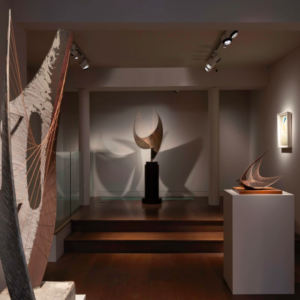
There was a time when the Turner Prize was glamorous and exciting, but nowadays it favours a more serious approach, which has produced intelligent, provocative shortlists. This strategy, however, can backfire if it makes contemporary art seem too stern or obscure for a wider audience to grasp. And there is a very real fear that that has happened this year.
In order to be a successful the Turner Prize has to tread a fine line between the hubris of the 90s and a rigorous examination of the immediate unfolding of art history. This year’s shortlist is comprised of four artists who are quite unknown despite two of them having shown last year at the Venice Biennale. There are more artists in the world today than one could possibly discover, so we should not be too alarmed that we have not seen the work of Duncan Campbell, James Richards, Ciara Philips and Tris Vonna-Michell. In Adrian Searle’s professional opinion – which is to be trusted like that of a pope – the shortlist is ‘dour’ and ‘difficult’. Indeed, at a glance the work is esoteric: video works which require unfathomable patience to watch, full of obscure references and clever techniques that nobody understands.
This might be a calculated attempt to encourage engagement of a more scholarly, archaeological kind, as if the Tate is trying to make the Turner Prize as forbiddingly uninspiring as some of its exhibitions. The problem is that this is one of those scarce moments when that which is normally confined to private galleries and salesrooms ceases to be an object of dethatched voyeurism that we cannot quite reach and becomes the common intellectual property of a democratic society that engages freely with culture. In the attempt to avert a shallow media circus, it risks alienating the very people whom it is supposed to enlighten and entertain.
But the Turner Prize has the seeds of a media circus in its very loins. The prize is awarded to a British (or German or Palestinian or French) artist under 50 for a significant presentation of work in the preceding twelve months. But what they don’t make entirely clear is that the work presented in the exhibition is not necessarily that for which they have been nominated. So the palaver over Tracey Emin’s bed ignored the fact it was made for the exhibition only and Mark Wallinger’s State Britain gave the false impression that he is a serious artist when really he was nominated for walking around a museum dressed as a bear. This deliberate misrepresentation ensures the standing possibility of a furore.
The Turner Prize has always courted controversy. It realised at a tender age that the most economical way of getting people to pay attention is to make a monumental spectacle of itself. It would like to maintain the veneer of a serious art prize by denying this, but I wouldn’t trust as far as I could throw a serious art prize that nominates Lucian Freud twice and never gives him the award.
It was all lols and top bants in the 90s when art itself was little more than a media circus, and now that art has calmed down so too has the Turner Prize. Gone are the days when the Culture Secretary wrote his Epistle to the Tate complaining of ‘conceptual bullshit’, when Chris Ofili inspired an illustrator to dump poo on the steps of Tate Britain, when Madonna swore live on Channel 4 while presenting the prize, or when a pair of Japanese ‘performance artists’ ransacked Emin’s carefully composed bed. Gone are the days when the Turner Prize was an endless splurge of tabloid headlines and generally an absolute hoot, so thank God for the good old Stuckists, who to this very day mount a devoted picket outside the exhibition.
So art has changed, but people haven’t: a public which treats contemporary art as a family excursion – rather an obsession, occupation or money laundering scheme – is still a hungry fish in search of the bate. There needs to be something in the shortlisted artists which immediately, viscerally captures the imagination. It’s not that the prize should be populist or aesthetically shallow, but just that it’s greatest merit is public engagement with the otherwise closed field of contemporary art. In 2011, it was Karla Black’s use of make-up and bath salts to create rolling, dusty landscapes of colour that reminded one of Refreshers; in 2012 it was the high camp of Marvin Gaye nee Spartacus Chetwynd’s performance; and in 2013 David Shrigley delighted audiences with a weeing statue and life drawing classes. But this year I am struggling to find that accessible, bitesize riff that can hook the hungry but docile fish swimming along in the big culture pond.
The Turner Prize knows that the media circus is good for business. The real drama occurs behind closed doors, where the race is not for the prize, but for the public commissions, museum shows and inflated auction prices. In 2002 Grayson Perry was under the public radar, but the intoxicating power of media uproar, the chattering of artless idiots, Victoria Miro’s publicity machine and his eventual win landed him a show at the British Museum and the honour of delivering the Reith Lectures. The transvestite potter shtick was the hook that caught the media and the public, creating the right kind of publicity, leading to millions for everyone.
There is no doubt that this year’s obscure nominees will be both somewhat less obscure and somewhat richer by December. But let us remember that the Turner Prize is not for the profit of these people. It is for us to discover new artists, to engage in debate and to experience the cutting edge of contemporary art in the immediacy of the moment. It looks as if this year’s difficult shortlist has tried to thwart this effort from the outset, but we should certainly not let the artworld fill its pockets while we sit here baffled.
We have until September to make our acquaintance with these artists in theory before we can see their work in practice. If we don’t do our homework and find something to get excited about, the Tate will have succeeded in making contemporary art inaccessible, inscrutable and boring. So it’s time to wake up and smell the formaldehyde: the Turner Prize is a precious opportunity to get involved in the great hullabaloo of contemporary art. And it is not one to be sniffed at because when Frieze comes round, everyone will be so busy filling their Versace pockets with gold that nobody will want to hear your opinion.
Words: Daniel Barnes







